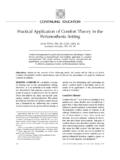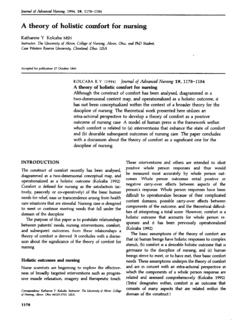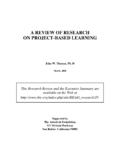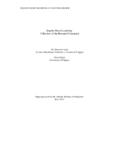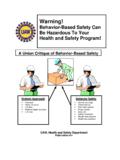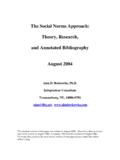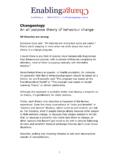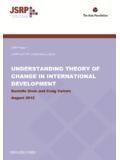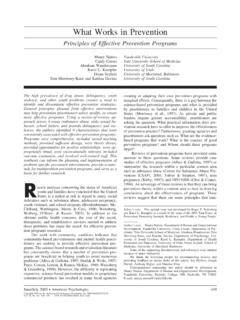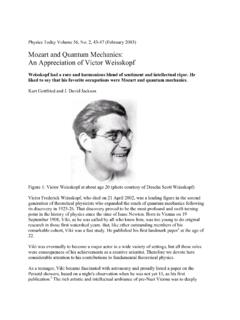Transcription of Evolution of the Mid Range Theory of Comfort for …
1 Evolution of the Mid Range Theory of Comfort for Outcomes Research Katharine Kolcaba, PhD, RN, C. The developmental stages of the mid Range Theory of Theory or practice guidelines, or from a combination of these Comfort are discussed in this article, which includes its In this article, the Evolution of one MR Theory , the philosophic orientation and its inductive, deductive, Theory of Comfort , will be discussed. The Theory states that, in and retroductive reasoning. Other steps that are stressful health care situations, unmet needs for Comfort are described are the concept analysis of Comfort , the met by nurses. Nursing interventions are successful if operationalization of the outcome of patient Comfort , the application of the Theory in previous nursing enhanced Comfort is achieved by patients compared with a studies, and the evaluation of the current Theory as it previous baseline.
2 The immediate patient outcome of has been adapted for outcomes research. This article enhanced Comfort is theoretically Thus, is a guide that shows how a concept grows, becomes enhanced Comfort is directly and positively related to patients embedded in Theory , is tested, and is adapted for the engaging in health-seeking behaviors (HSBs), called subse- rapidly changing health care environment. The quent patient outcomes. Further, when patients are able to Theory of Comfort also offers a way to reconceptu- engage in HSBs, they report that their satisfaction with health alize nurse productivity. care is high. High patient satisfaction leads to a competitive edge in negotiations with employers and financial viability for W hether theories are grand or mid Range (MR), they organize disciplinary thinking and influence practice and research.
3 By definition, grand theories are abstract, the institution(s) involved. Variables that are related to this competitive edge, and which are related to institutional integrity, are called institutional outcomes. This Theory is complicated, and removed from practice. They are not meant humanistic, holistic, and based on patient needs. The history to be easily grasped or tested. Compared with grand theories, of how this MR Theory was developed is presented. MR theories contain fewer concepts and relationships, are adaptable to a wide Range of practice and experience, can be The Theory states that, in stressful built from many sources, and are concrete enough to be health care situations, unmet needs For these reasons, MR theories are particularly cogent for Comfort are met by nurses.
4 As nursing science addresses the challenges of the 21st century. Foreseeable challenges that the discipline faces in the 21st century include (1) moving beyond descriptive studies to PHILOSOPHIC ORIENTATION. testing relationships between nursing care and desirable Kim3 classifies nursing theories into 3 categories on which outcomes in large populations of patients, (2) building scien- theorists base their work: (1) human needs, (2) adaptation, tific evidence to validate the impact that nursing has on the and (3) the health/illness continuum. In the first category, outcomes that patients care about, (3) conceptualize nursing clients are viewed in terms of the state that they are in with productivity based on these outcomes, and (4) being ready respect to what they need or require to be sustained or to grow.
5 With Theory -based data to support policy formulation that is Such is the orientation of the Theory of Comfort . relevant and visionary. MR theories are helpful for meeting Most scholars agree that all humans possess certain organic these challenges because they are concrete, adaptable, and easy or basic needs that must be satisfied for the sake of physical to use. MR theories also direct the questions to be asked and Other scholars build on this statement by arguing that facilitate significant, positive outcomes because of the congru- people have desires and aspirations that extend beyond physi- ency that working within a Theory necessitates. ologic or somatic needs. Those desires also must be satisfied to There are many methods by which MR Theory may be avoid dire consequences.
6 4 Desires and aspirations for social produced: armchair theorizing, theorizing from practice, support, to stay in their own homes, to be understood, to be induction, deduction, retroduction, substruction from existing financially stable, and to return to former function are entailed in the construct of holistic Comfort that embodies physical, Katharine Kolcaba is an associate professor at the University of Akron psychospiritual, social, and environmental Because the College of Nursing, Akron, Ohio. Theory is based on the needs of patients, it is a representation of what patients hope to receive from nurses who are assigned Nurs Outlook 2001;49:86-92. Copyright 2001 by Mosby, Inc.
7 To their care. 0029-6554/2001/$ + 0 35/1/110268 Two facets of human needs have been identified and described as reflexive. First, needs provide a motivational drive 86 Kolcaba VOLUME 49 NUMBER 2 NURSING OUTLOOK. Evolution of the Mid Range Theory of Comfort for Outcomes Research Kolcaba that directs human Patients have implicit and were they doing in the mean time? What behaviors did the explicit Comfort needs that, when met, strengthen them and staff hope they would exhibit that would indicate an absence motivate them to perform better in therapy, rehabilitation, of excess disabilities? Should the term excess disabilities be and learning/adhering to new health Second, needs further delineated for clarity?
8 Are a force that is driven by social and cultural Patient Partial solutions to these questions were to divide excess Comfort needs are driven by expectations, and patients expect disabilities into physical and mental and to introduce the nursing care that is competent and holistic. An additional concept of Comfort to the original diagram, because this word premise for the Theory of Comfort is that when nurses effec- seemed to convey the desired state for patients to be in when tively address the Comfort needs of patients, better patient and they were not engaging in special activities. These efforts institutional outcomes are achieved, such as improved patient marked the first steps towards a Theory of Comfort and satisfaction, successful discharges, and financial viability of the thinking about the complexities of the institution.
9 This premise was recently added to the Theory of The strategies used at this point were inductive, building Comfort through retroduction, after induction and deduction. from observations to a rudimentary conceptual framework of a specialized practice. Major concepts were used that were already Nurses can and should manipulate prominent in the field of dementia care; there were a manage- surrounding environmental able number of variables, and there was a pattern that was easily features such as noise, furniture, detectable. Assumptions were made that truth existed in real and ambiance to enhance patient life, that it could be captured through the senses, recorded in Comfort . terms of related concepts, and verified or falsified.
10 Thus, a framework for dementia care was developed and presented at a gerontologic conference, published, and opened to Whole person holism5 is at the core of the Theory of Comfort . This perspective holds that persons are in and Concept Analysis of Comfort surrounded by their environment. Nurses can and should Like most nursing conferences, the feedback that ensued was manipulate surrounding environmental features such as noise, thoughtful and thought-provoking. One observation from the furniture, and ambiance to enhance patient Comfort . This audience was that the framework was applicable to many view is congruent with Nightingale's6 view of the environment nursing settings and did not have to be limited in its scope to as an element that can aid healing and the restoration of dementia care.
